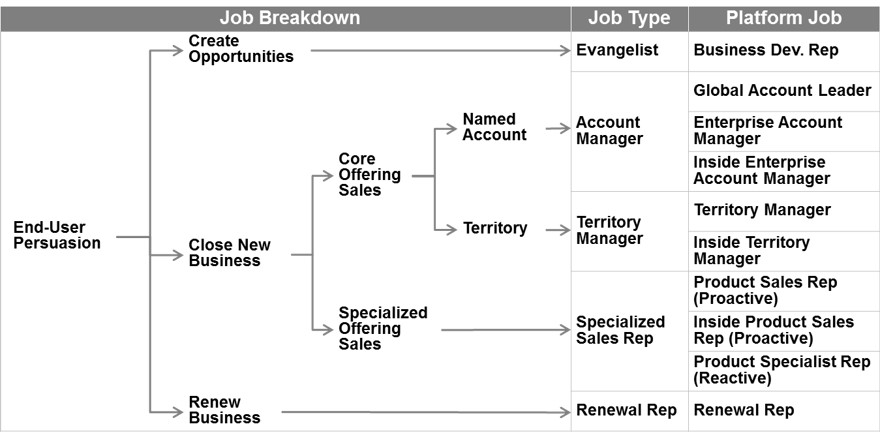Platform jobs: the secret to manage sales comp in big companies
Let’s face it, managing the sales compensation program can be a challenge with a small sales force. Imagine the challenges leaders face with not dozens, or even hundreds of reps, but literally 1000s of sales people, spanning across the globe, with hundreds of different job titles. How do you drive a consistent approach? It’s no wonder many companies get bogged down in complexity, turf battles and corporate bureaucracy. It’s not enough to have plan design “know how.” You have to have a management model and a disciplined process that guides the organization to success.
In an earlier post, we introduced Alexander Group’s Sales Compensation Program Management Framework, which has three key tenants:
1. Platform Jobs: Groupings of roles performing similar duties based on specific attributes
2. Sales Compensation Principles and Goalposts: Principles are a set of governing rules and best practices to steer compensation design decisions and program governance. Goalposts are a set of values or ranges for each compensation plan component based on best practices and company needs. (See related post here)
3. Sales Compensation Governance: Governance describes the internal process, roles and responsibilities and timing for end-to-end management of Sales Compensation (See related post here)
In this post, we dive into the details on Platform Jobs, including 1) what they are, 2) how to develop them, and 3) how to maximize their benefits.
1) What Are Platform Jobs?
As stated earlier, Platform Jobs are a grouping of roles that perform similar duties based on specific attributes. Example attributes include:
- Customer Focus: Direct, Partner, Technical
- Expertise: Generalist, Specialist
- Segment: Global, Large, Medium, Small
- Route to Market: Direct, Indirect, Both
- Sales Strategy: Convert New Customers, Retain Existing Customers, Penetrate Existing Customers
- Sales Process: Assess, Persuade, Fulfill, Renew, Optimize
- Deployment: Accounts, Narrow Geography, Wide Geography
- Management Responsibility: Individual Contributor, Team Leader, Manager
You should customize the appropriate attributes for your company based on your business type and coverage needs. For example, if you have a direct-only sales force you may not require route to market attributes.

Below is an example of a ‘Territory Sales Rep’ Platform Job developed for one client. The client had multiple job titles across their BUs and Segments that were essentially playing the same role, yet plan designs varied significantly across these roles. Yet in all cases, the ‘Territory Sales Rep’ focused on retaining and growing existing customers and acquiring new customers within an assigned geographic territory. This is a good example of the value of creating Platform Jobs.

It’s best to build a Decision Tree to clearly articulate each unique Platform Job (see example below). While tricky to build, Decision Trees are great tools for succinctly articulating the decision criteria for each platform job and on-going Platform Job management. If a sales manager wants to add a new job to the organization, he or she has to prove that the job does not already exist within the Decision Tree structure.
Example Platform Job Decision Tree

The number of Platform Jobs depends on range of business models, routes to market and sales motions. Some of the largest sales forces have up to 100 Platform Jobs. This may sound like a lot, but it’s not really, when compared to 1,000+ different job titles.
2) How to Develop Platform Jobs
Developing a set of Platform Jobs is not a simple task. It involves lots of fact-finding, documentation, task force meetings, decision making, mapping and implementation planning. The key steps include:
1) Collect, Document and Confirm Current Jobs and Their Attributes
- Gather all GTM, sales and HR job titles/descriptions, organization charts, and deployment data
- Create a job profile template (PPT and/or Excel) with all relevant attributes
- Interview and/or work with HR, Sales Ops, and Sales Mgmt. to complete job profile templates
- Split out job titles if multiple roles exist under that title
- Confirm local variations and needs (e.g., hybrid jobs in emerging countries)
2) Determine Key Attributes to Classify Jobs
- Determine key attributes to create the level one job classification
- Options include:
1. Job Families (e.g., Direct Field, Direct Inside, Specialist, Technical, Channel, Renewals)
2. Persuasion Points (End-User, Partner, Technical) - Socialize and confirm Job classification with HR and Sales Ops
3) Develop Platform Jobs and Decision Tree
- Review attributes for all jobs within each job classification to consolidate similar jobs into initial set of Platform Jobs
- Use additional attributes to build out a Decision Tree within each job classification that clearly results in a relevant Platform Job
- Update Platform Jobs based on Decision Tree design
- Use Decision Tree for communication and ongoing management
4) Map Current Jobs to Confirm Structure and Create Platform Job Profiles
- Map all current titles (HR titles, Business Titles, Comp Titles, etc.) to new Platform Jobs and identify gaps
- Work with HR, Sales Ops and Sales Comp to confirm structure
- Update/finalize Platform Jobs and Decision Tree based on mapping and feedback
- Create Platform Job profiles to summarize each unique job
5) Slot Incumbents to New Titles and Implement Changes
- Develop employee slotting worksheet and complete first pass slotting based on title mapping
- Work with HR and Sales Ops to complete slotting
- Develop transition strategy, communication work plan and materials
- Obtain approval from sales leadership
- Complete communications rollout
3) How to Maximize the Benefits of Platform Jobs
Building and managing a codified set of Platform Jobs has many sales coverage and sales compensation management benefits.
Sales Coverage Management: Platform Jobs are an effective framework to design, operationalize and assess job roles and productivity
- Jobs are consistently aligned to business needs and strategy across BUs, regions, segments, verticals
- Common language and framework to drive operational efficiencies for planning, deployment, enablement, reporting and sales comp (articulated below)
- Provide a framework to appropriately analyze and compare sales force metrics (e.g., sales cost analysis, headcount ratios, span of control) to drive accountability and productivity
- Evaluate how many resources actually reside in each platform role to better manage coverage and COS objectives.
Sales Compensation Management: Platform Jobs are an effective framework to design, manage and assess sales compensation pay levels and plans
- Inform job mapping with 3rd party survey sources to improve pay level benchmarking
- Application of best-in-class plan design ‘goalposts’ (guidelines for pay mix, upside opportunity, measure types, performance period, etc.) to drive consistent and best practices
- Ensure incumbents within a platform job are assigned to the right plan to drive better alignment with company’s philosophies and market best practices
- Consolidate ‘similar’ plans within the same platform job to reduce plan proliferation
- Provide a framework to appropriately analyze and compare pay and performance analytics, sales force survey results, and plan assessments to improve plan design effectiveness
- Assess all plans against defined ‘goalposts’ to ensure alignment with company’s philosophies and market best practices
Call to Action
Do you manage a large sales organization? If so, how are you managing your job titles across HR, sales and compensation? Do you have the right number of job titles? Does your company use multiple roles within a job title, multiple job titles for the same role or both? Are you having challenges comparing analytics across different sales organizations with similar jobs?
Do you believe your company can benefit from developing Platform Jobs and a Decision Tree?
